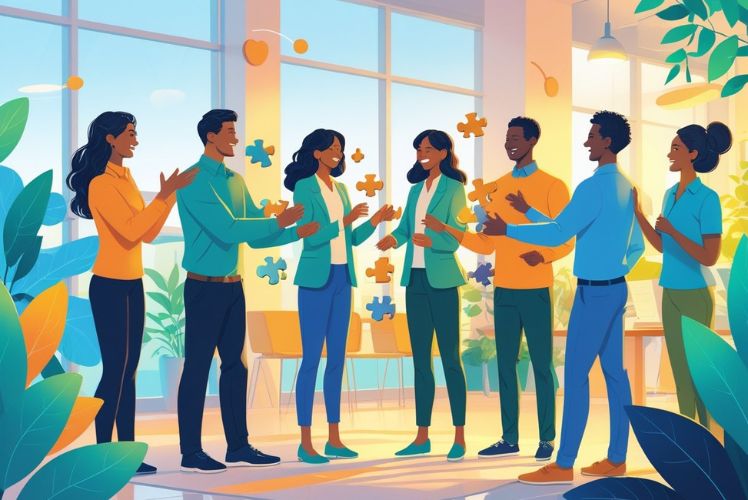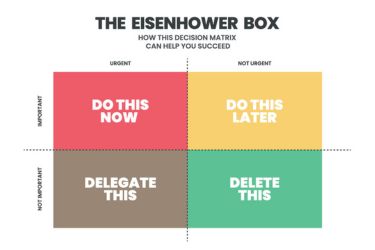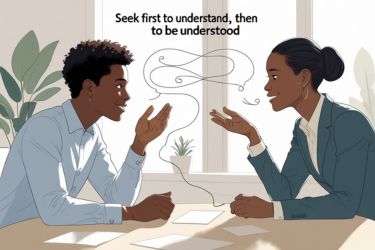When we talk about Steve Covey's Seven Habits, Habit 6: Synergise stands out as a powerful tool for working well with others. Synergy means achieving better results together than we could alone, showing us the real value of teamwork and cooperation. By using this habit in our daily lives, we can find creative solutions that make the most of everyone's strengths.

Synergising is more than just working in a group; it’s about truly listening, valuing different viewpoints, and building on each other's ideas. When we practise this, we experience stronger relationships and better outcomes at work, school, or home. The real benefit comes when we remain open-minded and trust each other, allowing unique skills and ideas to blend together for the best possible result.
Key Takeaways
- Synergy helps us achieve more by working together.
- Valuing differences leads to better solutions.
- Habit 6 is key to improved teamwork and results.
Understanding Synergise as Habit 6

Synergise, as described in Habit 6 of The 7 Habits of Highly Effective People, is about people working together to create outcomes that none could achieve alone. It is about creative teamwork, valuing differences, and finding solutions that bring greater results.
Definition of Synergy
Synergy means that the whole is greater than the sum of its parts. When we synergise, we combine our strengths and talents to produce something better than anything we could do by ourselves.
In Covey’s model, synergy is often shown as the equation 1 + 1 = 3, or even more. This shows that together, we are more powerful and effective. Success is found when we value diversity and welcome new perspectives.
When we look for synergy, we listen carefully and respect what others bring to the table. By blending ideas, skills, and backgrounds, we reach solutions that no individual could find on their own.
The Habit of Creative Cooperation
The habit of creative cooperation sits at the heart of synergy. We practise this habit by openly sharing our ideas and respecting others, even those with very different views.
Creative cooperation means that we are not just agreeing to keep the peace. Instead, we use our differences to spark new ideas. We trust each other and seek win-win outcomes, building teams where everyone’s contribution matters.
We see cooperation as a chance to tap into everyone’s best thinking. This creates an environment where problems are not only solved, but turned into opportunities for growth and innovation.
Synergy Versus Compromise
Synergy and compromise are not the same. When we compromise, each person gives up something, often leaving nobody fully satisfied. The result is usually an average solution—one that meets in the middle.
With synergy, we create a solution greater than what each of us could achieve alone. We aim for outcomes that please everyone and build stronger relationships in the process.
Here’s a simple table comparing the two:
| Aspect | Compromise | Synergy |
|---|---|---|
| Approach | Give and take | Creative collaboration |
| Result | Both lose something | Everyone gains more |
| Focus | Middle ground | New, better outcome |
Embracing synergy helps us unlock the full potential of our teams, leading to better results and a more positive atmosphere.
Principles and Benefits of Synergy

Synergy is a key principle in Stephen Covey’s 7 Habits of Highly Effective People. When we work together effectively, the group achieves results impossible for individuals alone. This process values differences, builds trust, and produces solutions greater than the sum of the parts.
Why Synergy Achieves Better Results
Synergy uses our collective strengths to overcome weaknesses. When we combine talents, skills, and perspectives, we unlock creative approaches we would not see alone. Different viewpoints help us spot risks, fill gaps, and refine ideas.
Often, teamwork leads to innovative solutions through open dialogue. We find that disagreements, when managed respectfully, create better outcomes rather than conflict. By encouraging input from everyone, we find answers that are both practical and original.
Working in synergy reminds us that 1 + 1 can truly equal 3 or more. We go past simple compromise and instead reach results none of us could get alone.
The Power of Unity and Teamwork
In effective teams, unity does not mean everyone is the same. Instead, it means we respect each other’s strengths and differences. By accepting different backgrounds and skills, we grow stronger together.
Unity brings trust. With trust, team members feel safe sharing ideas and giving honest feedback. This openness builds strong connections and helps us move quickly towards shared goals.
Often, synergy turns ordinary teams into high-performing ones. When we work as a single unit and trust each other, we take more responsibility, stay motivated, and achieve our targets more consistently.
Energising Collaboration
Synergy brings energy to collaboration. Working together with purpose gives us motivation and makes tasks more enjoyable. Each person’s enthusiasm lifts the group, making even hard work feel lighter.
As we collaborate, the sense of shared ownership increases. Everyone feels their contribution matters, and we become more committed to our results. This energy keeps us focused and helps us push through challenges.
Successful collaboration under synergy is not just about splitting up tasks. It is about blending our efforts so well that our team creates something bigger than what any of us could manage alone. Through synergy, we discover the real strength of working as a team.
Core Skills for Synergising

When we practise synergising, we bring together different ideas to create the best solutions. This process works best when we remain open-minded, communicate respectfully, and look for new ways to solve problems together.
Open-Mindedness and Valuing Differences
To synergise, we need to be open-minded and willing to listen to everyone in the group. We all have unique experiences, backgrounds, and skills. By embracing these psychological differences, we allow each person to contribute their strengths.
Open-mindedness means setting aside our own opinions and truly considering new viewpoints. It also means being curious and eager to explore ideas that may seem unfamiliar at first. When we value differences, we avoid groupthink and make stronger decisions.
We benefit when we invite others to share what makes them unique. This could be as simple as asking, “How do you see this situation?” or “What would you do differently?” Over time, these steps help us find unexpected solutions and build trust within the team.
Respectful Communication
Respectful communication is key to success when working together. We need to listen carefully and avoid interrupting others. By showing respect, we create a safe space for sharing even unusual or unpopular ideas.
We should use clear language when we talk and make sure everyone has a chance to speak. Body language matters, too; nodding, eye contact, and open posture all signal respect. When we disagree, it is best to focus on the idea instead of criticising the person.
Using strategies such as summarising what we hear or asking follow-up questions proves we value others’ input. This approach helps prevent conflicts and keeps the group moving forward.
Inventing New Approaches
Synergy is not just about combining ideas—it is about creating something better than what we could do alone. Inventing new approaches means we look beyond traditional solutions. We test out mixes of different ideas and methods to find what works best.
When everyone feels safe to suggest new approaches, creativity grows. We might brainstorm, try mind maps, or work in small teams to think through tough problems. The goal is to create a result where “the whole is greater than the sum of its parts.”
By blending our diverse perspectives through open discussion and teamwork, we often discover new ways forward that none of us would have found on our own. Tables and lists can help us organise ideas during these creative sessions, making it easier to spot links and gaps.
The Process of Achieving Synergy

Synergy does not happen by chance. It is a result of deliberate actions that involve building trust, sharing our different experiences and skills, and working together to find new and better solutions.
Building Trust for Creative Cooperation
Trust is the foundation of creative cooperation. Without trust, people will hesitate to share their real thoughts and ideas. This limits the potential of the group.
We build trust by being honest, listening actively, keeping promises, and respecting each person’s point of view. Simple steps — like delivering on commitments and accepting feedback — show we are reliable. When we show trust, others are more likely to trust us in return.
When trust is present, we are more comfortable discussing disagreements. This openness leads to more creative thinking, as we know our input is valued, even if it’s different. The group feels safer to take risks and explore new ideas together.
The Role of Personal Experience and Expertise
Everyone brings their own background, skills, and knowledge to the table. Our experiences shape how we solve problems, and our expertise offers unique insights.
By openly sharing what we know and what we have learned, we increase the group’s ability to understand complex issues. Respecting each person’s strengths is important. If we only listen to those who agree with us, we miss out on useful ideas.
A mix of experience and expertise allows us to look at problems from many angles. This diversity makes it easier to find creative solutions that we might never consider on our own. When we combine our strengths, we set the stage for real synergy.
Embracing the 3rd Alternative
The 3rd Alternative is about going beyond compromise. Instead of settling for what each side wants, we look for a new answer that benefits everyone.
This approach starts with a willingness to understand all viewpoints. We must ask honest questions and show respect for different needs. By doing this, we can uncover solutions that none of us would have found alone.
Often, the 3rd Alternative leads to completely fresh ideas that are better than anything we originally imagined. Achieving it takes time and effort, but the result is a solution that everyone supports, thanks to creative cooperation and mutual respect.
Practical Applications and Real-Life Examples
Synergy means combining our strengths to create better results than we could achieve alone. When we apply Habit 6, we focus on communication and creative problem-solving, leading to stronger teams and successful projects.
Synergising in Teams and Organisations
In teams, synergy happens when we recognise and value each person’s unique perspective and skills. For example, when working on a group project at work, combining our different backgrounds often leads to more thorough solutions.
We might break into smaller groups to brainstorm ideas separately, then bring everyone together to share insights. This approach often uncovers new possibilities that would not surface in individual work. In organisations, good leaders encourage open, respectful communication so that team members feel safe to share even unconventional ideas.
Key practices:
- Hosting regular team meetings focused on creative solutions
- Using active listening and encouraging input from everyone
- Setting clear, shared goals that align our efforts
When we collaborate in this way, trust grows and teamwork leads to results that truly reflect the best of everyone involved.
Challenges and How to Overcome Them
Synergy is not always easy to achieve. Sometimes, team members may feel threatened by different viewpoints or find it hard to listen openly. Conflicts can happen when communication breaks down or when we stick too rigidly to our own ideas.
To overcome these obstacles, we need to practise respectful communication. Setting ground rules for meetings—such as no interruptions and equal talk time—can help everyone feel heard. When disagreements occur, we should focus on understanding the reasons behind each person’s point of view rather than just defending our own.
It helps to remember that diversity makes us stronger. By treating differences as opportunities instead of problems, we can find creative cooperation even in tough situations.
Developing the Habit of Synergise
Building the habit of synergy starts with small, daily actions. We can look for chances to ask others for input and invite different opinions in our work. When facing a problem, instead of going it alone, we should reach out to colleagues or friends to brainstorm together.
Practising good listening is essential. This means putting aside our assumptions and paying close attention to what others are really saying. We might keep a simple list of how we contributed to team efforts that produced better outcomes than solo work.
By reflecting often on our collaborative experiences, we strengthen our teamwork skills and make synergy a natural part of the way we operate.
Frequently Asked Questions
Habit 6: Synergise emphasises teamwork, creativity, and valuing different viewpoints. By combining our strengths, we can discover solutions that we might not find alone.
What does 'Synergise' entail in the context of interpersonal relationships?
In our relationships, Synergise means truly listening to each other and working together to solve problems. We focus on understanding and respecting our differences rather than ignoring or fighting against them.
By valuing each person’s unique perspective, we can develop stronger, more creative solutions than we could by ourselves.
Can you provide an example of how Synergise can be applied in a team setting?
When a team works on a challenging project, everyone brings their own skills and experiences. If we share ideas openly and aim for the best result instead of just settling for compromise, we can come up with innovative solutions.
For example, a group with varied backgrounds may tackle a difficult task by blending technical know-how with creative thinking, producing a result better than any single member could achieve on their own.
How does the principle of 'Synergise' differ from mere cooperation?
Cooperation is about working together and getting along, but Synergise goes further. It is an active process where we seek out and embrace differences to create something new and better.
Instead of just agreeing or dividing tasks, we harness everyone’s strengths to build ideas that none of us could have created alone.
In what ways does 'Synergise' build upon the previous habits outlined by Covey?
Synergise relies on the earlier habits such as being proactive, beginning with the end in mind, and thinking win-win. These habits help us become more self-aware, goal-oriented, and fair.
Using these skills, we trust each other and communicate more openly, making it easier to find shared solutions and move forward together.
What are the key benefits of adopting Habit 6: Synergise in everyday life?
By practising Synergise, we can solve problems more effectively and build deeper relationships. This habit helps us discover solutions that are better than what any of us could create alone.
We also become more open-minded and learn to value the unique contributions of others, which can reduce conflict and increase success in both personal and group settings.
How can one effectively practise and develop the habit of Synergising in a professional environment?
To develop Synergise at work, we can invite diverse opinions and encourage honest conversations. Being open to different viewpoints helps us challenge our own ideas and spot blind spots.
We should also focus on shared goals and build trust within our teams. By recognising each person’s strengths, we create an environment where everyone feels valued and empowered to contribute.

















